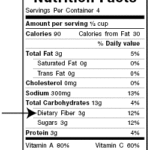Fruits and vegetables are full of tons of nutrients! Here in Newfoundland we have some of the lowest rates of fruit and vegetable intake and for sure a lot of different options aren’t readily available on this wonderful island we call a rock…BUT there are definitely ways we can get more fruits and vegetables into our diet! So why haven’t we? Let’s get to the root of the problem!
Firstly…before you get a chance to ask…”but what about all that stuff they said in the media lately about sugars and how we need to cut back because we are all consuming too much and it’s leading to obesity and other associated chronic diseases? I stopped eating fruit!” I will tell you. There is a huge difference between added, processed sugar and natural sugar! The biggest sources of added sugar are regular soda, sports drinks, fruit drinks, cakes and cookies, candy, ice cream and pie but there are also some products that are hiding added sugars and masquerading as healthy foods, these would be flavorings added to coffee and tea, cereals, flavored yogurts and granola or cereal bars. These are the products you need to be watching out for and cutting back on!
 Fruit is full of fibre, vitamins and minerals. Fibre is a complex carb and is still counted on your Nutrition Facts Table as a carb. Fibre however is not processed or broken down by the body so when looking at your Nutrition Facts Table it’s better to choose something high in fibre because the high carb count would be less likely due to added sugars! Check out my previous blog on cutting down on added sugar for more info (here).
Fruit is full of fibre, vitamins and minerals. Fibre is a complex carb and is still counted on your Nutrition Facts Table as a carb. Fibre however is not processed or broken down by the body so when looking at your Nutrition Facts Table it’s better to choose something high in fibre because the high carb count would be less likely due to added sugars! Check out my previous blog on cutting down on added sugar for more info (here).
Ok, so why the focus on fruits and vegetables?! Well, eating high amounts of fruits and vegetables is associated with lower incidence of some cancers and cardiovascular disease, PLUS it can be super helpful in maintaining a healthy weight or in assisting with weight loss. So many amazing benefits!
Now that we have all this info, how can you get more, how can you cook/prepare it, is fresh better than frozen?
Adding More Fruits and Vegetables to your diet (how much should I eat?):
- Try to have a serving of fruit with each meal. Cut down on your portion of cereal and add fruit to the top. Berries, cut up banana and apple all make delicious toppings on cereal, oatmeal and pancakes!
- Fruit is an excellent desert. You can still have cake on your birthday (and everyone else’s too) but try having fruit for dessert most days of the week.
- Have a serving of vegetables with lunch and supper. 1 cup of raw vegetables and ½ cup of cooked vegetables is equal to 1 portion.
- Visualize your supper plate, add your veggies first and try to fill half of the whole plate with veggies and then add your meat and starch/grain/carb afterwards.
- Grate fruits and veggies and add them to your favorite baked goods. Zuchinni and carrot can be grated and added to muffins, cakes or breads. Fruit can be substituted for both oil and sugar. Cut the sugar content of any recipe in half and add pureed fruit like mashed banana or apple sauce.
How should you cook or prepare your Fruits and Vegetables?
- Cooked or raw it’s really your preference!
- Avoid boiling vegetables (unless you are making a soup or stew). A lot of the nutrients in vegetables are water soluble and get lost during the cooking process in the water which you then throw out.
- Try steaming vegetables. Veggies like broccoli and green beans taste amazing steamed and it only takes 6 minutes total.
- Roasted vegetables are also delicious. Veggies like broccoli and brussel sprouts lose their super strong flavor when roasted. Especially if you cook them along with potatoes and an onion, add a little oil and some basil and oregano! Roast them on 375F for approx 30 minutes! Turn halfway through.
- Fry them in a frying pan for stir fry! Tip: Green veggies should be bright green, when they start to turn olive green they have been cooked too long and have lost some of the essential nutrients.
Is fresh better than frozen?
The Great Debate (after the added sugar fiasco of course). Newfoundland is an island so, much of our produce is shipped. Now the nutrients in vegetables and fruits break down over time. Each day after they are harvested they degrade and add handling and transportation to that…by the time the food gets to our plate a lot of the nutrients have been lost. Enter frozen and canned foods. Prior to being frozen or canned, produce is blanched. This means it is dipped in boiling water for a timed interval and then removed quickly and flash frozen or dipped in ice water to stop the cooking process. This blanching process is required to stop the enzymes present in produce which cause the produce to rot over time. Side note: the browning that happens to an apple after it is cut is an enzyme process. The blanching and freezing keeps the produce at the peak of their nutrition. So…prepare yourselves for this…frozen fruits and vegetables can sometimes be a healthier option! If you don’t believe me I would encourage you to read some articles on the subject such as this one: here. This time of year makes it particularly important for this little tid bit of information because fresh fruit and veggies basically double in price during the winter.
Hopefully you’ve learned a little after reading this article! Fruits and Veggies are an important part of our diet. Eat more, experiment with new kinds and eat them the way you enjoy them!
Signing off,
Adrianna Smallwood, RD
Registered Dietitian and Nutrition Expert!








